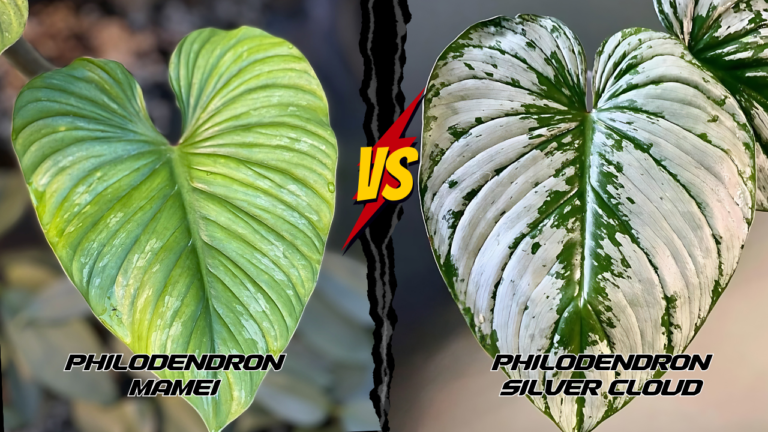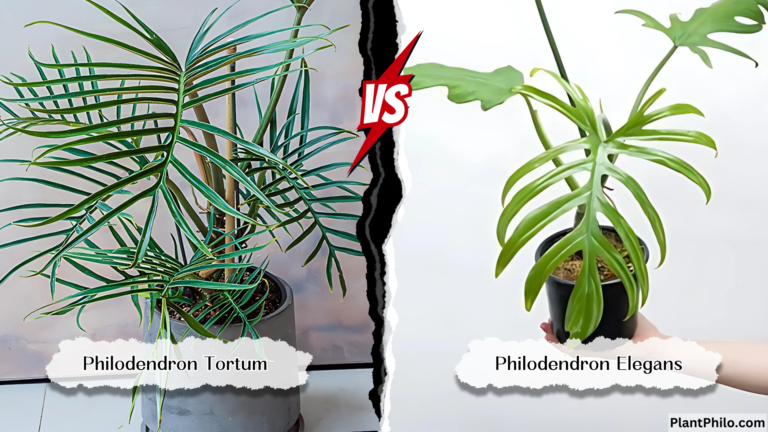Atabapoense vs. Billietiae – Can You Spot the Imposter?
Have you ever thought about what makes Philodendron Atabapoense different from Billietiae? These two plants can seem extremely similar, making it difficult to tell them apart if you are new to plants. This guide will help you figure out what each plant is and how to spot it.
Philodendron Atabapoense has shiny leaves that reflect silvery light, while young leaves of Philodendron Billietiae sometimes have a faint reddish coloration. One distinction I find important is that Billietiae usually tends to have petioles that are orange or red, unlike green or slightly reddish stems typical for Atabapoense.
| Feature | Philodendron Atabapoense | Philodendron Billietiae |
| Leaf Shape | Arrow-shaped, can become elongated | Consistently heart-shaped or oval |
| Leaf Color | Deep green with burgundy underside | Green with slightly pinkish underside |
| Petiole | Green or slightly red, up to 2 ft. long | Orange or reddish, shorter |
| Stem | Green or slightly brown | Green or brown, reddish tips when young |
| New Leaf Color | Deep green | Sometimes reddish |
| Growth Habit | Vining, slower-growing | Vining, faster-growing |
| Soil | Well-draining aroid mix | Well-draining aroid mix |
| Temperature | 70-85°F (21-29°C) day, above 60°F (15°C) night | 70-85°F (21-29°C) day, above 60°F (15°C) night |
| Humidity | High (60-80%) | High (60-80%) |
| pH Level | 5.0-7.0 | 5.0-7.0 |
| Rarity & Price | Less rare, less expensive | Rare, more expensive |
| Other Notes | More compact, prefers consistent care | Larger, more adaptable |
Apart from these visible differences both have particularities in growth habit as well as care needs. Knowing this stuff isn’t just about identification – it’s also about providing proper care for your specific type of plant. Such knowledge makes us empowered parents who know better.
Key Takeaways
- Billietiae generally has orange or reddish petioles.
- Atabapoense features leaves with a silvery sheen.
- Both plants need bright, indirect light and well-draining soil.
A Look at Lineage
Unique characteristics of the Philodendron Atabapoense and Billietiae were shaped by their different origins. Understanding where they come from helps us understand how best we should take care of them based on those backgrounds.
Philodendron Atabapoense (Species)
This species comes originally from South America’s tropical rainforests specifically along Rio Atabapo in Venezuela and Colombia. Warmth & humidity abound naturally here which provides an ideal environment for growth; some climb up trees due to their nature while others remain grounded but all share one thing in common – dark green leaves with burgundy undersides developed under various lighting conditions found within the forest itself.
Indoor care for such plants involves recreating their natural environment as much as possible, so bright indirect light is required, together with high humidity levels, which can be achieved by placing them near sources like bathrooms or using humidifiers if necessary. It is also recommended not to allow water stagnation around roots by ensuring a proper drainage system in the potting soil mix used since this kind usually grows slower than most others, making it more manageable indoors.
Philodendron Billietiae (Species)
This plant originates from Brazil where it grows beneath taller trees within the understory layer of Amazonian rainforests; they have long & narrow leaves which are vibrant green but may show some slight pinkish hue on undersides at times. Its petioles are characterized by having bright orange coloration that distinguishes them among other philodendrons.
Billietiae tends to grow faster compared with Atabapoense, reaching up to 2-3 feet tall when kept indoors, thus becoming a good option for those looking forward to faster maturation rates among their cultivated plant selection.
It requires similar care conditions whereby it should receive bright indirect light and high humidity levels like the rest, although its unique feature is brought about by those red-orange stems, which might add an aesthetic touch to one’s interior garden setting.
Decoding the Leaves: A Visual Guide
Knowing how Philodendron Atabapoense and Billietiae differ visually does not have to be overwhelming – there are certain key points we can focus on such as shape, color, size & venation; these will help you identify them easily whenever encountered hence making our lives simpler while dealing with plants recognition challenges.
Shape
Arrow-shaped leaves, which may appear more rounded or fuller as the plant matures, are a common characteristic of Philodendron Atabapoense. The lobes could elongate, giving them an elongated look too.
On the other hand, Philodendron Billietiae has large heart-shaped or oval leaves that tend to maintain their shape consistently thus making it easier for identification purposes mostly.
Color
The vibrant green leaves of Philodendron Atabapoense are well known for their striking purple-burgundy undersides. This color contrast is quite significant and can be easily noticed even from a distance.
The Philodendron Billietiae is generally seen with green leaves and slightly pinkish undersides. The stalks or petioles of this plant are often an intense orange or reddish color, making them very noticeable.
Size
Both plants can grow leaves that reach 8-12 inches in length when conditions are right.
Philodendron Atabapoense may have slightly smaller leaves on average.
Venation
Both have a pronounced venation.
For Philodendron Atabapoense, the veins are often lighter green than the darker green color of the leaf surface. This provides a beautiful contrast.
In Philodendron Billietiae, although similar to those in A., veins sometimes have this yellowish look that gives the leaf more texture.
Examining the Stems and Petioles
Stem comparison is vital for distinguishing between Philodendron Atabapoense and Billietiae. Thus, one should be aware of these differences because they help to tell one plant from another as per their stem characteristics.
Stems
Philodendron Atabapoense typically has stems that are green or slightly brown; making it even more delicate looking. Given its growth habits that are vine-like in nature, Atabapoense tends to grow on supports such as moss poles or trellises.
However some Billietiae stems might also be green with brown colorations; but, when still young exhibit much redder tones particularly at their tips. The appearance of orange hue is what tells you whether it is an Atabapoense or Billietiae: beware!
Petioles (leaf stalks)
The petioles of Philodendron Atabapoense can either be green like those on their stems or they may show slight reddishness. These petioles can grow up to huge lengths such as 2 feet long in some cases giving rise to elongated petiole which makes it look elegant and graceful when standing amongst other plants in your garden.
In contrast, the petioles of Philodendron Billietiae stand out due to their unique orange or reddish coloring. This vibrant hue is often more pronounced than that of Atabapoense. Another feature that makes billietiae quite distinctive is its shorter petioles compared with atabapoense.
Both the plants have slightly flexible and strong petioles which enables them to adapt to their changing environments of growth. This color difference is especially helpful for novice observers.
Growth Habit and Care Requirements
Philodendron Atabapoense and Billietiae are climbing aroids that require specific light, water, and soil conditions to thrive. Let us examine their growth habits and care needs so that you can understand how best to maintain these beautiful plants.
Growth Pattern
Both Philodendron Atabapoense as well as Billietiae are climbers that greatly benefit from support structures such as moss poles or trellises.
Given space and support, Atabapoense can climb up to 10 feet high hence it becomes a floor-to-ceiling focal point in your house. On the other hand, Billietiae usually reach between 2-3 feet while outgrowing Atabapoense. Both can be trained into growing uprightly thereby giving you flexibility on how they should look like after.
Light
Light requirements for both Philodendron Atabapoense and Billietiae are quite similar. They prefer bright, indirect light.
Direct sunlight can scorch their leaves, causing unsightly marks. If you notice the leaves fading in color, it might be a sign that they are getting too much direct light. Positioning them near an east or west-facing window with filtered light can help them thrive without any leaf damage.
Watering
These Philodendrons need watering. Both Atabapoense and Billietiae must be watered when the top inch of soil dries out.
Excess watering can lead to root rot, a common problem with houseplants. Ensure that the pot has holes in the bottom so that water does not stagnate. During the growing season, you may need to increase the frequency of watering them, whereas in winter, watering can be reduced.
Soil
Both Philodendron Atabapoense and Billietiae thrive in a well-draining aroid mix.
A mix containing peat, perlite, and orchid bark can provide moisture retention balance and aeration. Avoid heavy potting soils which retain too much water as this may cause root rot. Adding some organic matter also helps foster healthy growth.
Additional Notes
Humidity is crucial for either plant. They prefer environments with increased levels of humidity ranging from around 50% – 60%.
It is important to maintain temperatures between 70°F – 85°F during daytime and not dropping below 60°F at night for them to grow well.Regular misting or using humidifiers may help achieve required humidity especially in dry climates since they both are relatively slow growers. Patience is the key.
Identification: Cracking the Code
To properly identify Philodendron Atabapoense from Billietiae, one needs to break down their distinguishing features, such as leaf shape, leaf color, and stem/petiole coloration.
Leaf Shape
The leaves of Philodendron Atabapoense are dark green arrowheads with elongated lobes that develop as the plant matures. Conversely, Philodendron Billietiae often has leaves that maintain a more consistent heart or oval shape; its leaves tend to remain uniform in shape throughout, giving it a neater structured look, so knowing these subtle differences can make each identifiable at a glance.
Leaf Color
There is quite a distinct difference between the leaf colors of these two plants. While philodendron Atabapoense exhibits a bright burgundy underside on its dark green upper side, philodendron billietiae has slightly rose-tinged undersides beneath light green topside, so knowing these tones will enable you to identify them easily.
Stem and Petiole Color
One can differentiate these species by looking at their stems as well as petioles because they have different colors.
For instance, Philodendron Atabapoense usually possesses a reddish-green colored stem, whereas, in contrast, Philodendron Billietiae features orange-hued petioles, which are unique among other varieties even from afar.
Frequently Asked Questions
There might be some peculiarities about Philodendron Atabapoense and Billietiae that could leave you wondering. Here are answers to common questions people ask concerning these plants.
What is the difference in leaf morphology between Philodendron Atabapoense and Billietiae?
Philodendron Atabapoense has arrow-shaped leaves that are dark green with burgundy undersides, while on the other hand, philodendrons billietiae exhibits heart-shaped ones having green or slightly rose-tinged lower surfaces along orange petiole length.
What are the differences in care requirements for Philodendron Atabapoense and Billietiae?
Both plants like bright lights but not direct sunlight. They do best when temperatures during the day range from 70-85°F (21-29°C) and at night stay above 60°F (15°C). Ensure that soil is moist but not waterlogged, and keep humidity levels around 50-60%. For additional information, refer to this Philodendron Atabapoense care guide.
Can you describe how the Philodendron Atabapoense grows compared to Billietiae?
Philodendron Atabapoense can reach up to ten feet tall over time, but its growth rate is slow. Conversely, Philodendron Billietiae has a faster growth rate and typically only grows two to three feet tall. Both benefit from being supported by a moss pole or trellis.
Why might there be such a big difference in price between Philodendron Billietiae and Atabapoense?
The cost of Philodendron Billietiae is often higher because it has orange petioles which no other plants have as well as being very popular among collectors. Although strikingly beautiful in appearance, Attapospoens are generally less sought after thus making them cheaper.
Are there any variegated forms of these plants – Philodendron Atabapoense and Billietiae – that are worth mentioning?
Currently, variegated varieties of Philodendron Billietiae are more common in the plant market than ever before; they feature stunning patterns with cream or yellow splashes. However, philodendron Atabapoense has very few variegates available, but those few that exist are highly prized.


